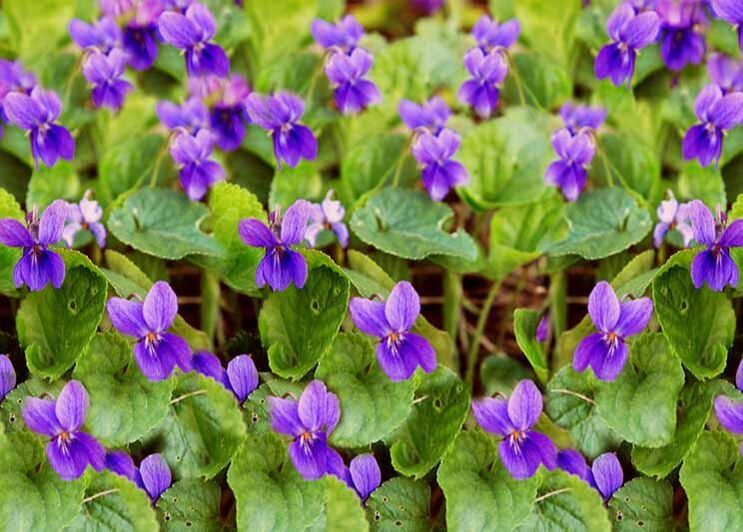How to grow violets

Not to be confused with their showier cousin the pansy, sweet violets (the flower of Eliza Doolittle) have a heavenly scent and hide in the springtime lawn beneath trees. A quintessential woodland flower, welcome in any garden, violets will spread through runners to create a charming ground cover if you treat them well.
Violets prefer damp, well-drained ground, and the sun-dappled protection of woodlands. The most common varieties range from purple sweet violet (Viola odorata), to dog violets such as the larger North American violet (V. cucullata), to V. labradorica ‘Purpurea’, which has purple leaves.
With more than 500 varieties of Viola (which includes the large-flowered pansy that goes by the name V. wittrockiana), you can find one to match any colour palette.
Violet’s flowers can be purple, blue, white, red, pink, orange, and yellow, all of which look charming in clumps at the front of a garden bed. But be warned. These self-seeding flowers often produce hybrids that look nothing like what you originally planted. Enjoy the surprise.
Violets are beloved for their dainty five-petalled flowers that are borne in profusion in spring. The term ‘violet’ is generally used to refer to different hardy perennial species in the Viola genus, including sweet or wild violet, dog violet and horned violet. Violets produce tiny flowers on short stems in spring, on low-growing or spreading plants with rounded green or purple-flushed leaves. Flowers are typically blue, with white, pink and purple colours also available. Some violets are sweetly scented, particularly sweet violet, Viola odorata. The flowers are an important early-season source of nectar for bees and other insects. Violet flowers are edible and can be candied to use for cake decoration or used fresh to scatter on salads.
Don't confuse violets with other members of the Viola genus, which is large and diverse and includes the pansy, Viola x wittrockiana. Confusingly, 'viola' is also the name given to short-lived bedding plants, similar to pansies but that flower in spring and summer. What's more, there are other, completely unrelated plants that have ‘violet’ as part of their name: the best-known of these are the house plant African violet, Streptocarpus, and the pond plant water violet, Hottonia palustris.
Grow violets from seed or buy ready-grown plants to put in many different situations around the garden, ideally in groups for effect as violets are small. Once established, violets need little care and can spread by means of runners, or self-seed to create larger groups or drifts.
Where to grow violets
Sweet violet, Viola odorata
Violets do best in full sun or partial shade, in soil that's fertile with plenty of organic matter, and which drains well. Grow violets in a woodland garden, on rockeries and banks, at the front of borders or under shrubs with an open canopy that only cast a light shade.
How to plant violets
Violets are hardy and can be planted at any time of year when soil and weather permit. If conditions are dry, ensure plants are kept watered until they have established. When planting in groups, space plants 15cm apart.
Violets need little care once established. The flowering on mature plants may decline, and plants can be rejuvenated by lifting, dividing and replanting.
Sow seed in autumn for those species that need a period of cold to germinate, such as sweet violet, Viola odorata, and place in a cold frame or an unheated sheltered spot outside. Species that don’t need cold can be sown in spring. Established plants can be divided in autumn or spring, and you can also propagate them from summer cuttings.
Violets prefer damp, well-drained ground, and the sun-dappled protection of woodlands. The most common varieties range from purple sweet violet (Viola odorata), to dog violets such as the larger North American violet (V. cucullata), to V. labradorica ‘Purpurea’, which has purple leaves.
With more than 500 varieties of Viola (which includes the large-flowered pansy that goes by the name V. wittrockiana), you can find one to match any colour palette.
Violet’s flowers can be purple, blue, white, red, pink, orange, and yellow, all of which look charming in clumps at the front of a garden bed. But be warned. These self-seeding flowers often produce hybrids that look nothing like what you originally planted. Enjoy the surprise.
Violets are beloved for their dainty five-petalled flowers that are borne in profusion in spring. The term ‘violet’ is generally used to refer to different hardy perennial species in the Viola genus, including sweet or wild violet, dog violet and horned violet. Violets produce tiny flowers on short stems in spring, on low-growing or spreading plants with rounded green or purple-flushed leaves. Flowers are typically blue, with white, pink and purple colours also available. Some violets are sweetly scented, particularly sweet violet, Viola odorata. The flowers are an important early-season source of nectar for bees and other insects. Violet flowers are edible and can be candied to use for cake decoration or used fresh to scatter on salads.
Don't confuse violets with other members of the Viola genus, which is large and diverse and includes the pansy, Viola x wittrockiana. Confusingly, 'viola' is also the name given to short-lived bedding plants, similar to pansies but that flower in spring and summer. What's more, there are other, completely unrelated plants that have ‘violet’ as part of their name: the best-known of these are the house plant African violet, Streptocarpus, and the pond plant water violet, Hottonia palustris.
Grow violets from seed or buy ready-grown plants to put in many different situations around the garden, ideally in groups for effect as violets are small. Once established, violets need little care and can spread by means of runners, or self-seed to create larger groups or drifts.
Where to grow violets
Sweet violet, Viola odorata
Violets do best in full sun or partial shade, in soil that's fertile with plenty of organic matter, and which drains well. Grow violets in a woodland garden, on rockeries and banks, at the front of borders or under shrubs with an open canopy that only cast a light shade.
How to plant violets
Violets are hardy and can be planted at any time of year when soil and weather permit. If conditions are dry, ensure plants are kept watered until they have established. When planting in groups, space plants 15cm apart.
Violets need little care once established. The flowering on mature plants may decline, and plants can be rejuvenated by lifting, dividing and replanting.
Sow seed in autumn for those species that need a period of cold to germinate, such as sweet violet, Viola odorata, and place in a cold frame or an unheated sheltered spot outside. Species that don’t need cold can be sown in spring. Established plants can be divided in autumn or spring, and you can also propagate them from summer cuttings.
